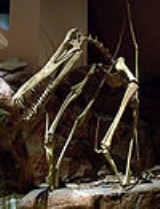
1922 in paleontology
Encyclopedia
Insects
| Name | Novelty | Status | Authors | Age | Unit | Location | Notes | Images |
|---|---|---|---|---|---|---|---|---|
Hydriomena? protrita Hydriomena? protrita Hydriomena? protrita is an extinct species of moth in the family Geometridae, and possibly in the modern genus Hydriomena. The species is known from late Eocene, Priabonian stage, lake deposits near the small community of Florissant in Teller County, Colorado, USA.-History and... |
sp. nov |
valid |
|
Priabonian Priabonian The Priabonian is, in the ICS's geologic timescale, the latest age or the upper stage of the Eocene epoch or series. It spans the time between and... |
Florissant Formation |
 United States United States |
A geometrid moth |
|
Newly named dinosaurs
Data courtesy of George OlshevskyGeorge Olshevsky
George Olshevsky is a freelance editor, writer, publisher, amateur paleontologist, and mathematician living in San Diego, California.Olshevsky maintains the comprehensive online Dinosaur Genera List...
's dinosaur genera list and Dr. Jeremy Montague's dinosaur genus database.
| Name | Status | Authors | Notes | Images | |
|---|---|---|---|---|---|
| Alamosaurus Alamosaurus Alamosaurus is a genus of titanosaurian sauropod dinosaur from the Late Cretaceous Period of what is now North America. It was a large quadrupedal herbivore. Isolated vertebrae and limb bones indicate that it reached sizes comparable to Argentinosaurus and Puertasaurus, which would make it the... |
Valid taxon |
|
|||
| Dromaeosaurus Dromaeosaurus Dromaeosaurus was a genus of theropod dinosaur which lived during the Late Cretaceous period , sometime between 76.5 and 74.8 million years ago, in the western United States and Alberta, Canada. The name means 'running lizard'.... |
Valid taxon |
|
Barnum Brown Barnum Brown , a paleontologist born in Carbondale, Kansas, and named after the circus showman P.T. Barnum, discovered the second fossil of Tyrannosaurus rex during a career that made him one of the most famous fossil hunters working from the late Victorian era into the early 20th century.Sponsored... |
||
| Erectopus Erectopus Erectopus is an allosauroid theropod from the Lower Cretaceous of France.The material comprising the type series was discovered in the late 19th century from the Phosphate-bearing beds of La Penthèive at Louppy-le-Château in eastern France, which have also produced remains of plesiosaurs,... |
Valid taxon |
Friedrich von Huene Friedrich von Huene was a German paleontologist who named more dinosaurs in the early 20th century than anyone else in Europe.-Biography:... |
|||
| Parasaurolophus Parasaurolophus Parasaurolophus is a genus of ornithopod dinosaur that lived in what is now North America during the Late Cretaceous Period, about 76.5–73 million years ago. It was an herbivore that walked both as a biped and a quadruped. Three species are recognized: P. walkeri , P. tubicen, and the... |
Valid taxon |
|
|||
New taxa
| s="wikitable sortable" align="center" width="100%"> | ||||
| Name | Status | Authors | Notes | |
|---|---|---|---|---|
Eurycleidus Eurycleidus Eurycleidus is an extinct genus of plesiosaur. The type species is E. arcuatus, which lived during the Hettangian age . Like other plesiosaurs, Eurycleidus probably lived on a diet of fish, using its sharp needle-like teeth to catch prey. Its shoulder bones were fairly large, indicating a powerful... |
Valid |
Andrews |
||
Leptocleidus Leptocleidus Leptocleidus is an extinct genus of pliosaurid plesiosaur, belonging to the family Leptocleididae. It is the only known pliosaur to be found in sediments on the Isle of Wight.-Etymology:In short, the term Leptocleidus means "slender clavicle"... |
Valid |
Andrews |
||
Non-mammalian
| Name | Status | Authors | Discovery year | Age | Unit | Location | Notes | Images |
|---|---|---|---|---|---|---|---|---|
Dvinia Dvinia Dvinia was a therapsid mammal-like "reptile" of the family Dviniidae found in Sokolki on the Northern Dvina River near Kotlas in Arkhangelsk Oblast, Russia... |
Valid |
|||||||
Eosimops Eosimops Eosimops is an extinct genus of non-mammalian synapsid.-References:*... |
Valid |
|||||||
Inostrancevia Inostrancevia Inostrancevia is a genus of gorgonopsid therapsid found in Sokolki, on the Smaller Northern Dvina River near Kotlas in Arkhangelsk Oblast, Russia. The animal lived 251 million years ago during the Late Permian. The species I... |
Valid |
|||||||
Oligokyphus Oligokyphus Oligokyphus was an advanced herbivorous cynodont of the late Triassic to early Jurassic periods. Originally considered to be an early mammal, it is now classified as a synapsid because Oligokyphus does not have the mammalian jaw attachments and it retains a vestigial joint between the quadrate... |
Valid |
|||||||
Venjukovia Venjukovia Venjukovia is an extinct genus of non-mammalian synapsid from the Middle Permian of Russia.-References:*... |
Valid |
|||||||

